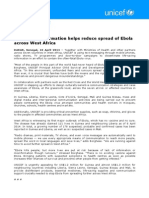Key Figures: Children and AIDS: Sixth Stocktaking Report, 2013
Uploaded by
api-235121531Key Figures: Children and AIDS: Sixth Stocktaking Report, 2013
Uploaded by
api-235121531KEY FIGURES
Children and AIDS: Sixth Stocktaking Report, 2013 Did you know that, in West and Central Africa
Good news 1. Over the past two years, the number of pregnant women living with HIV who received more effective antiretroviral medicines for the prevention of mother-to-child transmission has increased by 43%.
2. In some countries, the majority of pregnant women living with HIV have now access to antiretroviral medicines e.g. Ghana (95%), Sierra Leone (93%), Liberia (87%), Togo (86%), Gabon (70%), Cte dIvoire (68%), Burkina Faso (66%) and Cameroon (64%).
3. Over the past three years, the number of new HIV transmissions among children has decreased by 19% in West and Central Africa, with notable declines in Ghana, Sierra Leone and Togo. But 4. Only 3 out of 10 pregnant women living with HIV receive the more effective antiretroviral medicines they need to keep their babies free of HIV.
5. More than 1 out of 4 pregnant women living with HIV still pass on HIV to their babies. This is one of the highest mother-to-child transmission rates in the world, after South Asia and Middle East and North Africa. 6. Last year an additional 98,000 children were reported as having acquired HIV in West and Central Africa.
7. Only 1 out of 6 children below fifteen living with HIV receive the treatment they need. This is one of the lowest coverage rates in the world and one of the biggest gaps between adults and children.
United Nations Childrens Fund Three United Nations Plaza New York, New York 10017
Telephone 212 326 7000 Facsimile 212 888 7465 212 888 7454 www.unicef.org
8. More than two thirds of adolescents newly infected with HIV are girls.
9. The number of AIDS-related deaths has more than tripled among adolescents over the past ten years to reach nearly 27,000 in 2012.
10. Over 4 million children orphaned to AIDS in the region; much remains to be done to address their needs and that of their careers.
You might also like
- Get On The Fast-Track: The Life-Cycle Approach To HIVNo ratings yetGet On The Fast-Track: The Life-Cycle Approach To HIV57 pages
- Turning The Tide On HIV/AIDS in Children and YouthNo ratings yetTurning The Tide On HIV/AIDS in Children and Youth36 pages
- For Every Child End AIDS ST7 2016 Executive SummaryNo ratings yetFor Every Child End AIDS ST7 2016 Executive Summary4 pages
- Knowledge of Hiv Transmission and Sexual Behavior Among Zimbabwean Adolescent Females in Atlanta, Georgia: The Role of Culture and Dual SocializationFrom EverandKnowledge of Hiv Transmission and Sexual Behavior Among Zimbabwean Adolescent Females in Atlanta, Georgia: The Role of Culture and Dual SocializationNo ratings yet
- Children Infected & Affected By: Hiv/ AidsNo ratings yetChildren Infected & Affected By: Hiv/ Aids13 pages
- Children Infected & Affected By: Hiv/ AidsNo ratings yetChildren Infected & Affected By: Hiv/ Aids13 pages
- The Bravest Boy I Know: A UNAIDS Publication With Pictures by Sujean Rim Discussion GuideNo ratings yetThe Bravest Boy I Know: A UNAIDS Publication With Pictures by Sujean Rim Discussion Guide4 pages
- Global: Unaids Report On The Global Aids Epidemic - 2012No ratings yetGlobal: Unaids Report On The Global Aids Epidemic - 2012108 pages
- Tafelberg Short: The Politics of Pregnancy: From 'population control' to women in controlFrom EverandTafelberg Short: The Politics of Pregnancy: From 'population control' to women in controlNo ratings yet
- Children in A World of AIDS, October 2004No ratings yetChildren in A World of AIDS, October 20046 pages
- Unaids Fast Track Ending Aids Epidemic 2030 ReportNo ratings yetUnaids Fast Track Ending Aids Epidemic 2030 Report40 pages
- HIV Transmission and Prevention: Mother-to-Child (Perinatal)No ratings yetHIV Transmission and Prevention: Mother-to-Child (Perinatal)5 pages
- HIV/AIDS in The Last 10 Years: Abdalla Sidahmed OsmanNo ratings yetHIV/AIDS in The Last 10 Years: Abdalla Sidahmed Osman7 pages
- Strategies for Awareness & Prevention of Hiv/Aids Among African-Americans: A Hand BookFrom EverandStrategies for Awareness & Prevention of Hiv/Aids Among African-Americans: A Hand BookNo ratings yet
- "Young African Women Are Especially Vulnerable To Hiv/Aids" by Jon Cohen (Nov. 21, 2016)No ratings yet"Young African Women Are Especially Vulnerable To Hiv/Aids" by Jon Cohen (Nov. 21, 2016)3 pages
- Global Fact Sheet: World Aids Day 2012 New HIV InfectionsNo ratings yetGlobal Fact Sheet: World Aids Day 2012 New HIV Infections4 pages
- The United Nations and The Fight Against HIV/AIDSNo ratings yetThe United Nations and The Fight Against HIV/AIDS10 pages
- UN Secretary-General Outlines New Recommendations To Reach 2015 Goals For AIDS EngNo ratings yetUN Secretary-General Outlines New Recommendations To Reach 2015 Goals For AIDS Eng2 pages
- Ensuring Children and Adolescents Are Not Left BehindNo ratings yetEnsuring Children and Adolescents Are Not Left Behind2 pages
- Global Plan Elimination HIV Children by 2015No ratings yetGlobal Plan Elimination HIV Children by 201548 pages
- Global Hiv Statistics: Fact Sheet November 2016No ratings yetGlobal Hiv Statistics: Fact Sheet November 20168 pages
- Zamfara State School of Nursing and Midwifery, Gusau Department of Nursing Education Reproductive Health Iv Unit V: Hiv/Aids in ChildrenNo ratings yetZamfara State School of Nursing and Midwifery, Gusau Department of Nursing Education Reproductive Health Iv Unit V: Hiv/Aids in Children3 pages
- Overview of HIV Interventions For Young PeopleNo ratings yetOverview of HIV Interventions For Young People8 pages
- News Note: EMBARGO 00:01 GMT 27 NovemberNo ratings yetNews Note: EMBARGO 00:01 GMT 27 November2 pages
- Statement: UNICEF Calls For Immediate Release of Abducted School Girls in Chibok, Borno State, NigeriaNo ratings yetStatement: UNICEF Calls For Immediate Release of Abducted School Girls in Chibok, Borno State, Nigeria2 pages
- News Note: EMBARGO: 10 A.M. GMT / 11 A.M. CET/5:00 A.M. EST Friday, 6 February 2015No ratings yetNews Note: EMBARGO: 10 A.M. GMT / 11 A.M. CET/5:00 A.M. EST Friday, 6 February 20152 pages
- In CAR Capital, Bangui, UNICEF and Partners Are Setting Up Temporary Classrooms For Over 20,000 Displaced ChildrenNo ratings yetIn CAR Capital, Bangui, UNICEF and Partners Are Setting Up Temporary Classrooms For Over 20,000 Displaced Children3 pages
- Press Release: Life-Saving Information Helps Reduce Spread of Ebola Across West AfricaNo ratings yetPress Release: Life-Saving Information Helps Reduce Spread of Ebola Across West Africa2 pages
- EBOLA: Sub-Regional Snapshot: Guinea, Liberia, Sierra Leone, Côte D'ivoire, Senegal, Mali, Guinea-BissauNo ratings yetEBOLA: Sub-Regional Snapshot: Guinea, Liberia, Sierra Leone, Côte D'ivoire, Senegal, Mali, Guinea-Bissau2 pages
- Newsnote: UNICEF Fights Ebola Outbreak Amidst Child Deaths in GuineaNo ratings yetNewsnote: UNICEF Fights Ebola Outbreak Amidst Child Deaths in Guinea2 pages
- Key Developments:: UNICEF Central African Republic (CAR) Flash UpdateNo ratings yetKey Developments:: UNICEF Central African Republic (CAR) Flash Update2 pages
- UNICEF and Its Partners Respond To A Resurgence of Malaria Cases in ChadNo ratings yetUNICEF and Its Partners Respond To A Resurgence of Malaria Cases in Chad2 pages
- Press Release: UNICEF Provides Emergency Supplies To Treat Children Injured in Central African Republic FightingNo ratings yetPress Release: UNICEF Provides Emergency Supplies To Treat Children Injured in Central African Republic Fighting2 pages
- Press Release: UNICEF Gears Up To Help Over 500,000 Malian Children Return To SchoolNo ratings yetPress Release: UNICEF Gears Up To Help Over 500,000 Malian Children Return To School2 pages
- Press Release: Central African Republic: UNICEF Calls For An Investigation Into The Alleged Killings of ChildrenNo ratings yetPress Release: Central African Republic: UNICEF Calls For An Investigation Into The Alleged Killings of Children2 pages








































































